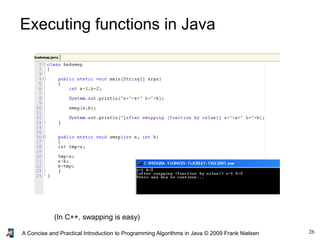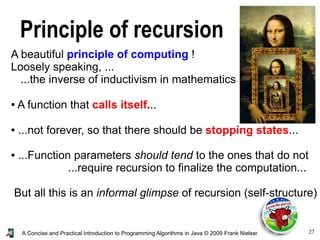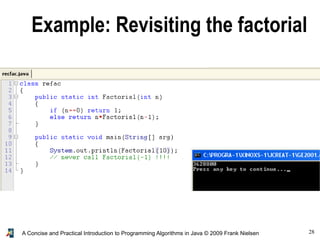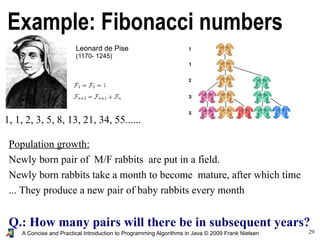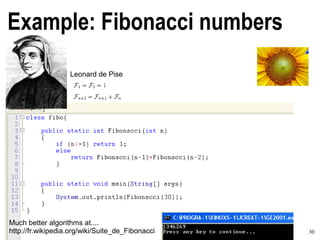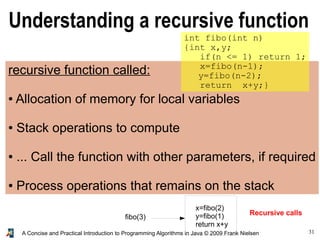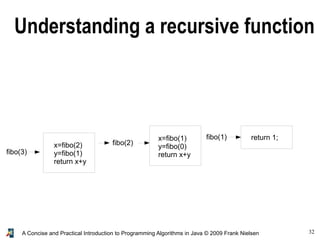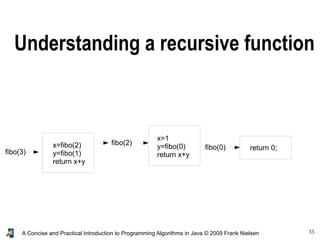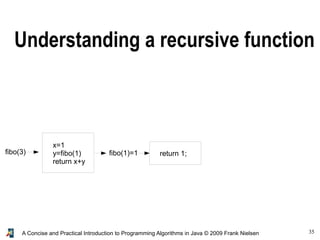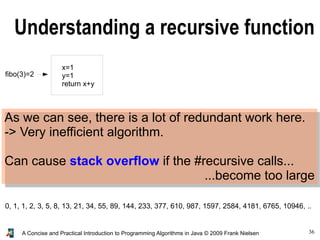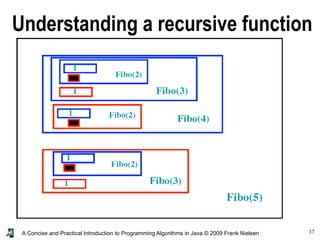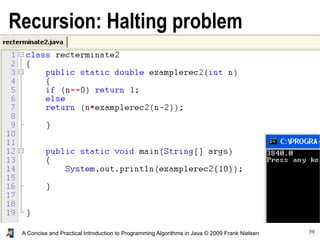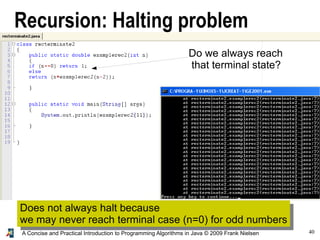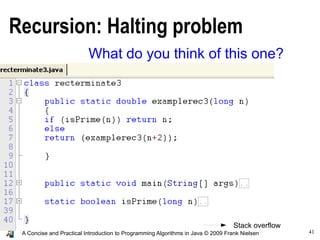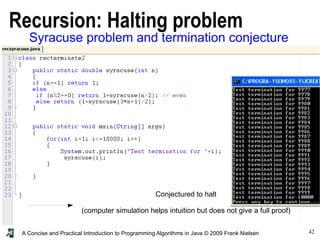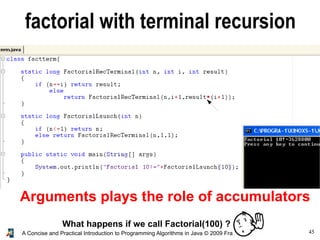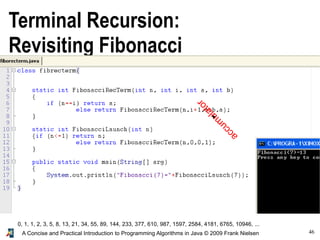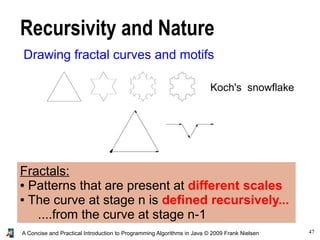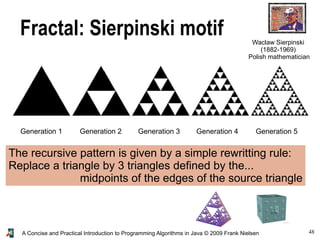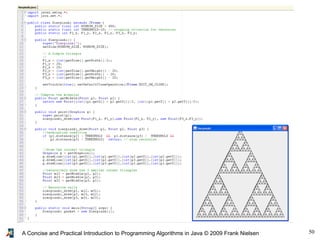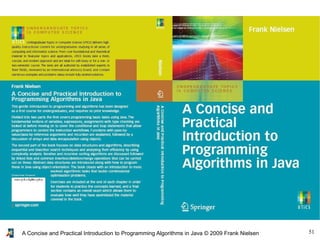(chapter 3) A Concise and Practical Introduction to Programming Algorithms in Java
- 1. 1A Concise and Practical Introduction to Programming Algorithms in Java © 2009 Frank Nielsen Frank NIELSEN [email protected] A Concise and Practical Introduction to Programming Algorithms in Java Chapter 3: Functions and recursivity
- 2. 2A Concise and Practical Introduction to Programming Algorithms in Java © 2009 Frank Nielsen So far... Executive review Lecture 1: Java=Typed compiled programming language Variables: Type var; (boolean, int, long, float, double) Assignment: var=Expression; (with type checking) Expression: Operand1 Operator Operand2 (+-*/%) Instruction (;) & comments // or /* */
- 3. 3A Concise and Practical Introduction to Programming Algorithms in Java © 2009 Frank Nielsen So far... Executive review Lecture 2: Program workflow (blocks/branching/loops) Determine the set of instructions at runtime Blocks: sequence of instructions { } Branching condition: if predicate B1 else B2 (switch case break) Loops: while, do, for and escaping break Numerical precisions: finite-precision arithmetic (absurd results, loose of associativity, etc.)
- 4. 4A Concise and Practical Introduction to Programming Algorithms in Java © 2009 Frank Nielsen Meaning of a function in mathematics ? ● Source (X) and target (Y) domains ● A map that associates to elements of X elements of Y ● An element of X is associated at most once to a member of Y ● The mapping gives always the same result (deterministic/no randomness) ● Functions of several variables may be built blockwise... ...using Cartesian product of spaces
- 5. 5A Concise and Practical Introduction to Programming Algorithms in Java © 2009 Frank Nielsen Meaning of functions for computing ? ● A portion of a program processing data and returning a result ●A function not returning a result is also called a procedure ●A function has typed parameters as arguments ●A function usually yields the same result for a given set of arguments (except for side-effects or use of pseudo-randomness) ● A function needs to be declared first before calling it elsewhere TypeF F(Type1 arg1, Type2 arg2, ..., TypeN argN) { TypeF result; block of instructions; return result; }
- 6. 6A Concise and Practical Introduction to Programming Algorithms in Java © 2009 Frank Nielsen class INF311{ public static typeF F(type1 arg1, ..., typeN argN) { // Description Block of instructions; } ... } ● This kind of function is also called a static method ● Functions must be defined inside classes ● A function not returning a result has type void (also known as a procedure) Declaring functions in Java
- 7. 7A Concise and Practical Introduction to Programming Algorithms in Java © 2009 Frank Nielsen Defining the body of a function in Java Class INF311{ public static typeF F(type1 arg1, ..., typeN argN) { // Description Block of instructions; } } Body of a function ● Body should contain an instruction return to indicate the result ● If branching structures are used (if or switch) , a return should be written for all different branches. Otherwise we get acompiler error!
- 8. 8A Concise and Practical Introduction to Programming Algorithms in Java © 2009 Frank Nielsen Defining the body of a function in Java class INF311{ public static typeF F(type1 arg1, ..., typeN argN) { // Description Block of instructions; } } Body of a function Body should contain an instruction return to indicate the result If branching structures are used (if or switch) , then a return should be written for all different branches. ... Otherwise we get a compiler error! (why? => not type safe!)
- 9. 9A Concise and Practical Introduction to Programming Algorithms in Java © 2009 Frank Nielsen Using functions in Java
- 10. 10A Concise and Practical Introduction to Programming Algorithms in Java © 2009 Frank Nielsen A few examples of basic functions class FuncDecl{ public static int square(int x) {return x*x;} public static boolean isOdd(int p) {if ((p%2)==0) return false; else return true;} public static double distance(double x, double y) {if (x>y) return x-y; else return y-x;} public static void display(double x, double y) {System.out.println("("+x+","+y+")"); return; // return void } public static void main (String[] args) { ... } }
- 11. 11A Concise and Practical Introduction to Programming Algorithms in Java © 2009 Frank Nielsen class FuncDecl{ public static int square(int x){...} public static boolean isOdd(int p) {...} public static double distance(double x, double y) {...} public static void display(double x, double y) {...} public static void main (String[] args) { display(3,2); display(square(2),distance(5,9)); int p=123124345; if (isOdd(p)) System.out.println("p is odd"); else System.out.println("p is even"); } } A few examples of basic functions
- 12. 12A Concise and Practical Introduction to Programming Algorithms in Java © 2009 Frank Nielsen Functions... JCreator IDE
- 13. 13A Concise and Practical Introduction to Programming Algorithms in Java © 2009 Frank Nielsen ● Modularity (ease of presentation) ● Code re-use (program once, re-use many times!) -> library (API) ● Ease certification of correctness and test routines. Benefits of using functions
- 14. 14A Concise and Practical Introduction to Programming Algorithms in Java © 2009 Frank Nielsen Functions with branching structures ERROR!!! This compiled but there is an error (break keyword?!)
- 15. 15A Concise and Practical Introduction to Programming Algorithms in Java © 2009 Frank Nielsen Functions with branching structures (correct program)
- 16. 16A Concise and Practical Introduction to Programming Algorithms in Java © 2009 Frank Nielsen Factorial function n! in Java Call function factorial in class « toolbox »
- 17. 17A Concise and Practical Introduction to Programming Algorithms in Java © 2009 Frank Nielsen Calling functions: Inner Mechanism TypeF result=F(param1, param2, ..., paramN); param1, ..., paramN should be of the same types as the ones declared in the function A function call can be used inside an expression, or even as a parameter of another function (nested calls) Example: F1(F2(x),F3(x)) Assignment's rule checks at compile time for type equivalence: System.out.println(IsPrime(23121971)); double dist=distance(u,v); Beyond the scope of the function's class, we need to put the function' class with a dot. Requires the function to be public. Math.cos(x); TD2.factorial(n); TC.lireInt();
- 18. 18A Concise and Practical Introduction to Programming Algorithms in Java © 2009 Frank Nielsen Revisiting IsPrime: measuring time We repeat this computation 1000 times to measure the elapsed time Function call in class TC: TC.demarrerChrono(); Function call in class TC: TC.tempsChrono();
- 19. 19A Concise and Practical Introduction to Programming Algorithms in Java © 2009 Frank Nielsen Potential side effects of functions: Static variables (effet de bord) ● Function that might modify/alterate the environment For example: ... displaying a value ... But also modify a variable of the base class ● A class variable is declared inside the class scope, ...not in function bodies ● Class variables are declared using the keyword static
- 20. 20A Concise and Practical Introduction to Programming Algorithms in Java © 2009 Frank Nielsen Side effects of functions: Static variables CountingCounting number ofnumber of function callsfunction calls Declaration of class variable static int classvar;
- 21. 21A Concise and Practical Introduction to Programming Algorithms in Java © 2009 Frank Nielsen Function: Signature and overloading signature of a function = ordered sequence of parameter types Two functions with different signatures can bear the same name (since the compiler can distinguish them!) static double plusone(...) int double String
- 22. 22A Concise and Practical Introduction to Programming Algorithms in Java © 2009 Frank Nielsen Although the function result type is important, Java does not take into account it for creating signatures... Function: Signature and overloading
- 23. 23A Concise and Practical Introduction to Programming Algorithms in Java © 2009 Frank Nielsen Function: Signature and overloading static int plusone (int n) static double plusone(int n) !!! COMPILATION ERROR !!! class SignatureError{ public static int plusone(int n) {return n+1;} public static double plusone(int n) {return n+1.0;} public static void main(String args[]) {} } C:JSignature.java:6: plusone(int) is already defined in SignatureError static double plusone(int n)
- 24. 24A Concise and Practical Introduction to Programming Algorithms in Java © 2009 Frank Nielsen Executing functions in Java ● Work place of the function is created when the function is called ● ... and destroyed once it is executed (value returned) ● Parameter values are equal to the results of the expressions ● Function parameters are allocated in memory reserved for the function ● If a parameter is modified inside the function body, it remains unchanged in the calling function. public static void main(String args[])
- 25. 25A Concise and Practical Introduction to Programming Algorithms in Java © 2009 Frank Nielsen Executing functions in Java Memory (stack) Memory for main Memory for Increment Memory for plusone As soon as we exit this function, k takes its original value of (5) passage par valeur
- 26. 26A Concise and Practical Introduction to Programming Algorithms in Java © 2009 Frank Nielsen Executing functions in Java (In C++, swapping is easy)
- 27. 27A Concise and Practical Introduction to Programming Algorithms in Java © 2009 Frank Nielsen Principle of recursion A beautiful principle of computing ! Loosely speaking, ... ...the inverse of inductivism in mathematics ● A function that calls itself... ● ...not forever, so that there should be stopping states... ● ...Function parameters should tend to the ones that do not ...require recursion to finalize the computation... But all this is an informal glimpse of recursion (self-structure)
- 28. 28A Concise and Practical Introduction to Programming Algorithms in Java © 2009 Frank Nielsen Example: Revisiting the factorial
- 29. 29A Concise and Practical Introduction to Programming Algorithms in Java © 2009 Frank Nielsen Population growth: Newly born pair of M/F rabbits are put in a field. Newly born rabbits take a month to become mature, after which time ... They produce a new pair of baby rabbits every month Q.: How many pairs will there be in subsequent years? Example: Fibonacci numbers Leonard de Pise (1170- 1245) 1, 1, 2, 3, 5, 8, 13, 21, 34, 55......
- 30. 30A Concise and Practical Introduction to Programming Algorithms in Java © 2009 Frank Nielsen Example: Fibonacci numbers Leonard de Pise Much better algorithms at.... http://fr.wikipedia.org/wiki/Suite_de_Fibonacci
- 31. 31A Concise and Practical Introduction to Programming Algorithms in Java © 2009 Frank Nielsen Understanding a recursive function recursive function called: ● Allocation of memory for local variables ● Stack operations to compute ● ... Call the function with other parameters, if required ● Process operations that remains on the stack int fibo(int n) {int x,y; if(n <= 1) return 1; x=fibo(n-1); y=fibo(n-2); return x+y;} x=fibo(2) y=fibo(1) return x+y fibo(3) Recursive calls
- 32. 32A Concise and Practical Introduction to Programming Algorithms in Java © 2009 Frank Nielsen x=fibo(2) y=fibo(1) return x+y x=fibo(1) y=fibo(0) return x+y return 1; fibo(3) fibo(2) fibo(1) Understanding a recursive function
- 33. 33A Concise and Practical Introduction to Programming Algorithms in Java © 2009 Frank Nielsen x=fibo(2) y=fibo(1) return x+y x=1 y=fibo(0) return x+y return 0; fibo(3) fibo(2) fibo(0) Understanding a recursive function
- 34. 34A Concise and Practical Introduction to Programming Algorithms in Java © 2009 Frank Nielsen x=fibo(2) y=fibo(1) return x+y x=1 y=0 return x+yfibo(3) fibo(2)=1 Understanding a recursive function
- 35. 35A Concise and Practical Introduction to Programming Algorithms in Java © 2009 Frank Nielsen x=1 y=fibo(1) return x+y fibo(3) fibo(1)=1 return 1; Understanding a recursive function
- 36. 36A Concise and Practical Introduction to Programming Algorithms in Java © 2009 Frank Nielsen x=1 y=1 return x+y fibo(3)=2 As we can see, there is a lot of redundant work here. -> Very inefficient algorithm. Can cause stack overflow if the #recursive calls... ...become too large 0, 1, 1, 2, 3, 5, 8, 13, 21, 34, 55, 89, 144, 233, 377, 610, 987, 1597, 2584, 4181, 6765, 10946, .. Understanding a recursive function
- 37. 37A Concise and Practical Introduction to Programming Algorithms in Java © 2009 Frank Nielsen Understanding a recursive function
- 38. 38A Concise and Practical Introduction to Programming Algorithms in Java © 2009 Frank Nielsen Recursion: Halting problem When does a recursive program terminate? The arguments always decrease and there is always a stopping criterion
- 39. 39A Concise and Practical Introduction to Programming Algorithms in Java © 2009 Frank Nielsen Recursion: Halting problem
- 40. 40A Concise and Practical Introduction to Programming Algorithms in Java © 2009 Frank Nielsen Does not always halt because we may never reach terminal case (n=0) for odd numbers Recursion: Halting problem Do we always reach that terminal state?
- 41. 41A Concise and Practical Introduction to Programming Algorithms in Java © 2009 Frank Nielsen What do you think of this one? Stack overflow Recursion: Halting problem
- 42. 42A Concise and Practical Introduction to Programming Algorithms in Java © 2009 Frank Nielsen Syracuse problem and termination conjecture Conjectured to halt (computer simulation helps intuition but does not give a full proof) Recursion: Halting problem
- 43. 43A Concise and Practical Introduction to Programming Algorithms in Java © 2009 Frank Nielsen There is provably no algorithm that can take as input a program (binary string) and return true if and only if this program halts. http://en.wikipedia.org/wiki/Halting_problem Halting problem: Computer Science Proof skipped
- 44. 44A Concise and Practical Introduction to Programming Algorithms in Java © 2009 Frank Nielsen Terminal recursion Does not put function calls on the stack (thus avoid stack overflow) What happens if we call Factorial(100) ? Recursive calls are alwaysof the form return f(...); ->No instruction (computation) after the function (Factorial is not terminal since return n*f(n-1); ) if (n<=1) return 1; else return n*f(n-1);
- 45. 45A Concise and Practical Introduction to Programming Algorithms in Java © 2009 Frank Nielsen factorial with terminal recursion Arguments plays the role of accumulators What happens if we call Factorial(100) ?
- 46. 46A Concise and Practical Introduction to Programming Algorithms in Java © 2009 Frank Nielsen Terminal Recursion: Revisiting Fibonacci 0, 1, 1, 2, 3, 5, 8, 13, 21, 34, 55, 89, 144, 233, 377, 610, 987, 1597, 2584, 4181, 6765, 10946, ... accum ulator
- 47. 47A Concise and Practical Introduction to Programming Algorithms in Java © 2009 Frank Nielsen Recursivity and Nature Drawing fractal curves and motifs Koch's snowflake Fractals: ● Patterns that are present at different scales ● The curve at stage n is defined recursively... ....from the curve at stage n-1
- 48. 48A Concise and Practical Introduction to Programming Algorithms in Java © 2009 Frank Nielsen Fractal: Sierpinski motif Generation 1 Generation 2 Generation 3 Generation 4 Generation 5 The recursive pattern is given by a simple rewritting rule: Replace a triangle by 3 triangles defined by the... midpoints of the edges of the source triangle Waclaw Sierpinski (1882-1969) Polish mathematician
- 49. 49A Concise and Practical Introduction to Programming Algorithms in Java © 2009 Frank Nielsen Sierpinski curve (2D pyramid) http://www.enseignement.polytechnique.fr/profs/informatique/Philippe.Chassignet/MACLIB/Java/maclib_java.html
- 50. 50A Concise and Practical Introduction to Programming Algorithms in Java © 2009 Frank Nielsen
- 51. 51A Concise and Practical Introduction to Programming Algorithms in Java © 2009 Frank Nielsen

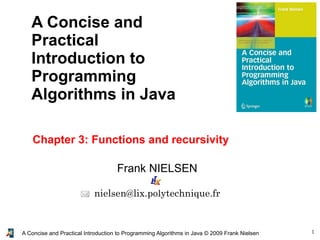


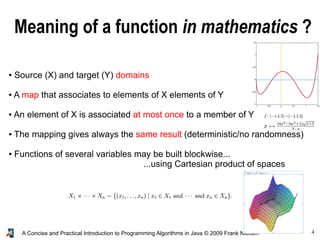
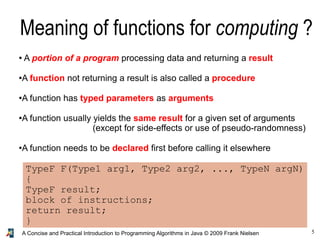
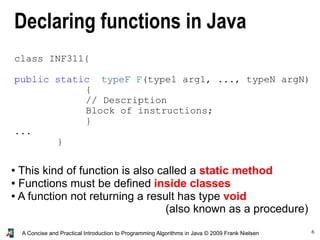
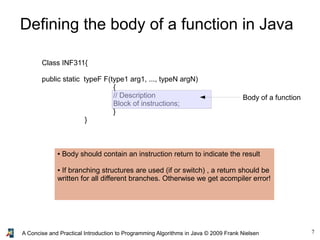
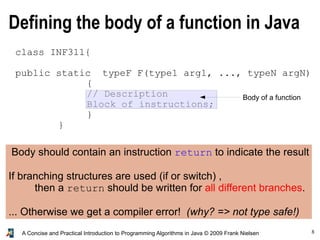
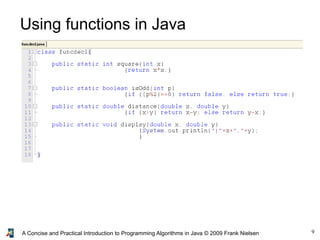
![10A Concise and Practical Introduction to Programming Algorithms in Java © 2009 Frank Nielsen
A few examples of basic functions
class FuncDecl{
public static int square(int x)
{return x*x;}
public static boolean isOdd(int p)
{if ((p%2)==0) return false;
else return true;}
public static double distance(double x, double y)
{if (x>y) return x-y;
else return y-x;}
public static void display(double x, double y)
{System.out.println("("+x+","+y+")");
return; // return void
}
public static void main (String[] args)
{
...
}
}](https://image.slidesharecdn.com/programmingalgorithmsjava-3-140701005310-phpapp01/85/chapter-3-A-Concise-and-Practical-Introduction-to-Programming-Algorithms-in-Java-10-320.jpg)
![11A Concise and Practical Introduction to Programming Algorithms in Java © 2009 Frank Nielsen
class FuncDecl{
public static int square(int x){...}
public static boolean isOdd(int p) {...}
public static double distance(double x, double y) {...}
public static void display(double x, double y) {...}
public static void main (String[] args)
{
display(3,2);
display(square(2),distance(5,9));
int p=123124345;
if (isOdd(p))
System.out.println("p is odd");
else System.out.println("p is even");
}
}
A few examples of basic functions](https://image.slidesharecdn.com/programmingalgorithmsjava-3-140701005310-phpapp01/85/chapter-3-A-Concise-and-Practical-Introduction-to-Programming-Algorithms-in-Java-11-320.jpg)

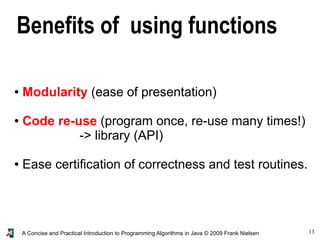

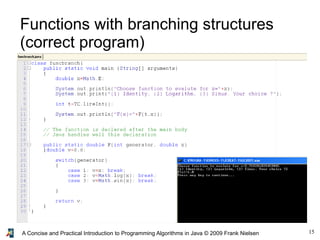

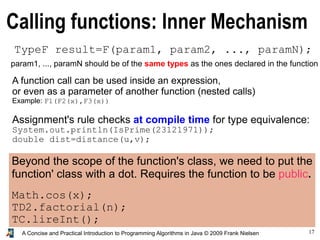
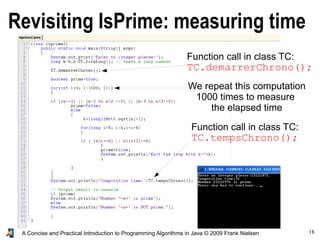
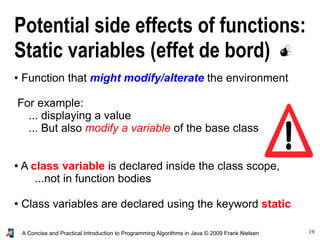
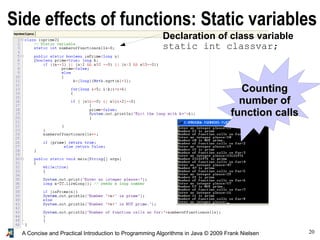
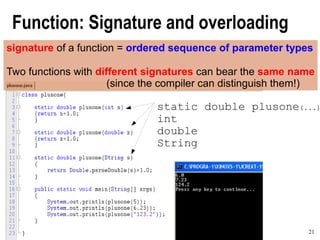
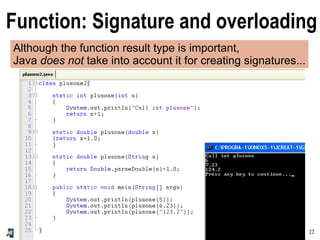
![23A Concise and Practical Introduction to Programming Algorithms in Java © 2009 Frank Nielsen
Function: Signature and overloading
static int plusone (int n)
static double plusone(int n)
!!! COMPILATION ERROR !!!
class SignatureError{
public static int plusone(int n)
{return n+1;}
public static double plusone(int n)
{return n+1.0;}
public static void main(String args[])
{} }
C:JSignature.java:6: plusone(int) is already defined in SignatureError
static double plusone(int n)](https://image.slidesharecdn.com/programmingalgorithmsjava-3-140701005310-phpapp01/85/chapter-3-A-Concise-and-Practical-Introduction-to-Programming-Algorithms-in-Java-23-320.jpg)
![24A Concise and Practical Introduction to Programming Algorithms in Java © 2009 Frank Nielsen
Executing functions in Java
● Work place of the function is created when the function is called
● ... and destroyed once it is executed (value returned)
● Parameter values are equal to the results of the expressions
● Function parameters are allocated in memory reserved for the function
● If a parameter is modified inside the function body,
it remains unchanged in the calling function.
public static void main(String args[])](https://image.slidesharecdn.com/programmingalgorithmsjava-3-140701005310-phpapp01/85/chapter-3-A-Concise-and-Practical-Introduction-to-Programming-Algorithms-in-Java-24-320.jpg)

